Servicios Personalizados
Revista
Articulo
Indicadores
Links relacionados
Compartir
Revista Latinoamericana de Desarrollo Económico
versión On-line ISSN 2074-4706
rlde no.24 La Paz nov. 2015
ARTÍCULO
The World Productivity Distribution: Convergence and Divergence Patterns in the Postwar Era
La distribución de la productividad mundial: convergencia y divergencia en el periodo de la posguerra
Carlos Alberto Méndez-Guerra *
Abstract
The post-World War II period has seen substantial changes in labor productivity around the world. Motivated by these changes, this article documents four stylized facts about the world productivity distribution. First, there is a large and increasing disparity between its tails. Second, this disparity rapidly increased in the 1980s, slowed down in the next decade, and stabilized in the mid-2000s. Third, overtime, there has been substantial forward and backward mobility of countries and regions. Forth, the upper tail the distribution is more sensitive to improvements in human capital, while the lower tail is more sensitive to improvements in technology. The article concludes pointing out that, at least in the near future, the world productivity distribution may still be characterized by divergence at the bottom, and convergence and overtaking at the top.
Keywords: labor productivity, world distribution, convergence, divergence
Resumen
En el periodo de la posguerra se han visto cambios sustanciales en la productividad laboral en el mundo. Este artículo documenta cuatro hechos estilizados sobre la distribución de la productividad mundial. Primero, existe una disparidad enorme y creciente entre las colas de la distribución. Segundo, esta disparidad incrementó rápidamente en la década de 1980, se desaceleró en la siguiente década, y finalmente se estabilizó a mediados de los años 2000. Tercero, existe substancial movilidad de países hacia adelante y hacia atrás. Cuarto, la cola superior es más sensible a mejoras en capital humano, mientras que la cola inferior es más sensible a mejoras en tecnología. El artículo termina señalando que, por lo menos en el futuro más cercano, la distribución-productividad mundial podría seguir siendo caracterizada por divergencia en los países más cercanos a la cola inferior, y convergencia y adelantamiento en los países más cercanos a la cola superior.
Palabras clave: productividad laboral, distribución mundial, convergencia, divergencia
Classification/Clasificación JEL: O40, 050, E10
1. Introduction
Both convergence and divergence in output per worker characterize the post-World War II period. The world productivity distribution shows a noticeable divergence at the bottom, and convergence and overtaking at the top. For example, in Taiwan average labor productivity relative to that in the United States increased from 13% to 78% between 1960 and 2010. Conversely, during the same period, labor productivity declined from 60% to 25% in Venezuela.
Motivated by these extreme cases, this article documents converge and divergence patterns in labor productivity for a representative sample of countries. In particular, it highlights four stylized facts about the world productivity distribution between 1960 and 2010. First, there is a large and increasing disparity between its tails. Second, this disparity rapidly increased in the 1980s, slowed down in the next decade, and stabilized in the mid-2000s. Third, overtime, there has been substantial forward and backward mobility of countries. Forth, the upper tail the distribution is more sensitive to improvements in human capital, while the lower tail is more sensitive to improvements in technology.
The first fact points out the large cross-section disparities in labor productivity since 1960. For example, in 1960 an average worker from the top of the distribution produced almost 40 times more than an average worker from the bottom. Also, the shape of the world productivity distribution in 1960 appeared unimodal and largely concentrated at the bottom, with 50% of the sampled countries showing a productivity level no greater than 17% relative to that in United States.
The second fact highlights the speed at which these disparities have been evolving over time. After more than two decades of relative stability, productivity disparities across countries rapidly increased in the mid-1980s. In the next decade, however, the speed of this divergence slowed down; and particularly since mid-2000s, the data suggest a small tendency towards convergence.
These two facts alone update and extend the previous literature. Parente and Prescott (1993) report stable differences in labor productivity across countries for the coverage period ending in 1985. The work of Duarte and Restuccia (2006) verifies this stability, and after extending the coverage period until 1996 documents a rapidly increasing dispersion. In this context, this article not only updates the disparity facts until 2010,but also provides some initial evidence on the stabilization of disparities due to recent improvements in the least productive countries.
The third fact documents substantial forward and backward mobility of countries and regions within the distribution. For example, Asias relative productivity increased from 15 to 37% between 1960 and 2010. In contrast, productivity declined from 28 to 23% during the same period in Latin America.
Given the previous thee facts, a natural question emerges: how might the world productivity distribution look in the future? Aggregate production function analysis provides some insights to answer this question. Jones (1997a) emphasizes that potential differences in labor productivity can be attributed to current differences in population growth rates, physical investment rates, human capital stocks, and technology levels. Using this approach, this article documents its forth stylized fact: the upper tail the distribution is more sensitive to improvements in human capital, while the lower tail is more sensitive to improvements in technology. Given this fact, and if current institutions and public policies remain in place, the world productivity distribution may still be characterized as bimodal in the future
A complementary framework to forecast the world productivity distribution uses historical mobility probabilities to estimate the steady state of a Markov chain. This is an approach taken by Quah (1993,1996) and Jones (1997b), among others. Using this framework, this article finds, one more time, that labor productivity may still be characterized by a bimodal distribution, with a small yet significant number of countries at the bottom.
Overall, this article contributes to the earlier literature in three ways. First, it adds the period between 1996 and 2010 to the analysis. Second, it characterizes disparity, mobility, and the steady-state distribution of labor productivity using trended data to abstract from business-cycle fluctuations. Third, it presents a more comprehensive view of the world productivity distribution in terms of its past, current, and expected trajectories.
The article proceeds as follows. Section 2 documents the main disparity and mobility facts of labor productivity across countries and over time. Section 3 evaluates the sensitivity of the world productivity distribution to improvements in capital accumulation and technology. Then, assuming a more distant time horizon, Sections 4 describes the distribution using Markov methods. Finally, Section 7 offers some concluding remarks.
2. Disparity and Mobility Facts
This section characterizes the cross-section dynamics of labor productivity around the world using a balanced sample of 92 countries for the period 1960-20101. Aiming to update and extend previous findings in the literature, the organization and presentation of this section follows closely the work of Duarte and Restuccia (2006).
2.1. Large and Increasing Disparities
Focusing on the top and bottom of the world productivity distribution, Figure 1 illustrates the labor productivity gap between the ten most productive and ten least productive countries for each year since 1960 until 2010. Over this period, the productive gap between the tails of the distribution varied from 39 to 68 times. By 2010, the average worker from the ten most productive countries produced 67.6 times more output than the average worker from the least productive group of countries. Historically, the first decade of the new millennia records the largest disparity between the tails of distribution in the post-World War II period.
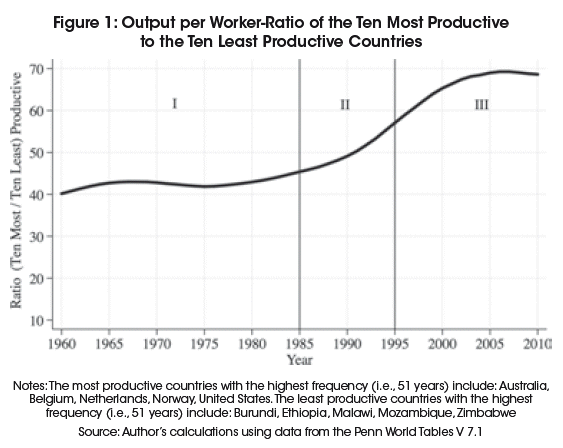
Consistent with earlier findings in the literature, Figure 1 suggests that the disparity between the tails of the distribution has been roughly constant during the first two decades of the sample period. Since the mid-1980s until the mid-2000s, however, there has been a rapid increase in the productivity gap between the top and bottom of the distribution2.
The first line drawn at 1985 represents the ending period of the first strand of the previous literature, which emphasizes constant disparities between the tails of the distribution. That literature includes the work of Parente and Prescott (1993), and Chari, Kehoe and McGrattan (1997). The second line drawn at 1995 represents the second strand of the earlier literature, which emphasizes rather increasing disparities. That literature includes the work of Duarte and Restuccia (2006).
Extending the findings of the earlier literature, Figure 1 also shows that since the mid-1990s this increasing productivity disparity has slowed down. Moreover, after 2006 the gap has stabilized and shifted its tendency. Evaluating more extensible the nature of this trend, Figure 2 suggests that the recent stabilization of the productivity gap is driven by improvements at the bottom of the distribution.
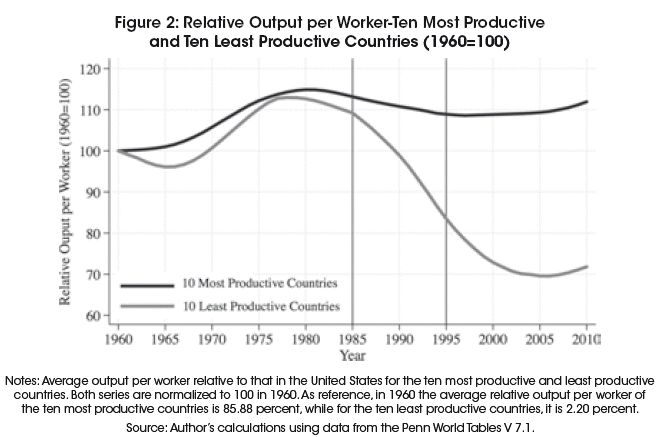
Figure 2 reports the relative labor productivity for the ten most productive and least productive groups, each normalized to 100 in 1960. Overall, this figure shows that the increase in the disparity between the tails of the distribution is mostly driven by the decline in productivity in the least productive countries. For example, from 1977 to 2006, their relative productivity decreased by 42%. Since 2006, however, the ten poorest countries have grown even faster than the ten richest countries. Although this positive growth episode ends up a 30-year period of productivity divergence, disparities are still substantially large.
When considering the entire distribution, the distribution of the sampled seems consistent with the "twin peaks" hypothesis (Quah, 1993a and 1993b, Quah, 1996 and Jones, 1997). Gaussian kernel densities evaluated at different points in time suggests a movement in the mass of countries from the middle to both right and left of the distribution. This polarization characterizes the third fact on the cross-sectional dynamics of labor productivity: substantial mobility within the distribution.
2.2. Substantial Mobility within the Distribution
Table 1 reports a mobility matrix based for seven groups of countries over a period of 51 years. The variable y indicates a countrys labor productivity relativity to that in the United States. The labels for each group are somewhat arbitrary cutoffs for low (L), upper low (UL), lower middle (LM), middle (M), upper middle (UM), lower-high (LH), and high (H) productivity levels. The first element ofthis matrix, 0.86, for example, indicates that out of all the low-productivity countries (L) in 1960, only 14% of those countries upgraded their status to upper-low productivity (UL) by the year 2010.
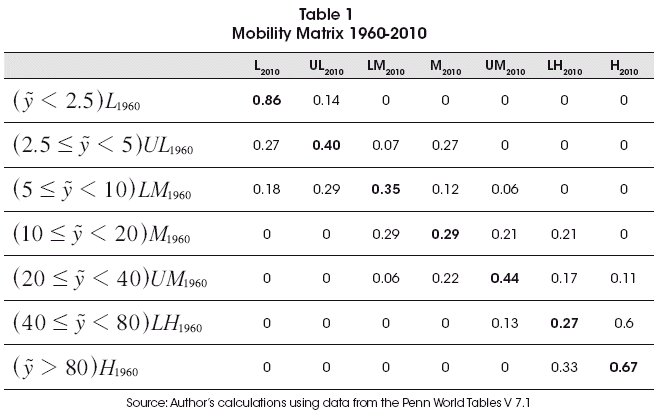
The matrix shows higher degree of mobility in the middle of the distribution compared to the extremes. Among all the middle-productivity countries, most improvements occurred for the high-productivity countries. For example, from all the lower-middle (LM) countries in 1960,35% remained in the same interval, 47% moved backwards, and 18% moved forward after 51 years. In contrast, from all upper-middle (UM) countries in 1960,44% remained in the same interval, 28% moved backwards, and 28% moved forward after 51 years. Overall, these results characterize the post-war period as having both convergence and divergence patterns (i.e., countries moving from the middle to both right and left of the labor productivity distribution).
Figure 3 characterizes the mobility within the distribution, yet this time the comparison is between the relative productivity of each country in 1960 and 2010. Countries above (below) the solid 45-degree line improved (deteriorated) their position relative to the United States. The dashed lines indicate the median relative productivity for each year. This figure is useful for identifying large convergence and divergence experiences. Countries with the largest productivity improvements include Taiwan, South Korea, China, Hong Kong, and Romania. In contrast, countries with the largest productivity deterioration include the Democratic Republic of Congo, Niger, Central African Republic, Nicaragua, and Madagascar.
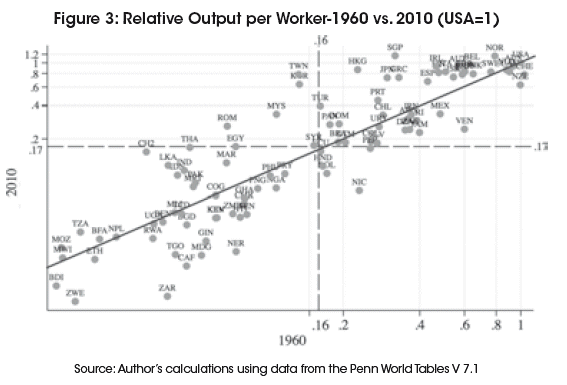
So far this section has presented three facts about the increasing disparity and mobility of the world productivity distribution. These facts, naturally, lead to the question: What will the distribution of labor productivity look like in the future?3 The following two sections attempt to answer this question based on the characterization of a steady-state (long-run) equilibrium in both a determinist and a stochastic setting.
3. Labor Productivity in the Long Run
This section uses economic theory to estimate the long-run (steady-state) distribution of labor productivity. Briefly, the following subsection describes the model suggested by Jones (1997a), which is a variation of the standard neoclassical growth model. In this framework labor productivity depends on the current equipment, skills, and technology available to workers. After introducing the model, the following subsections describe the variables and parameters that will be used in the computation of a steady-state distribution of output per worker for a sample of 85 countries4.
3.1. Model
Consider the following economy:

where Y is total output, which is produced by physical capital K, human capital H, and labor-augmenting technology (TFP5) A. Human capital or skilled labor is produced by raw labor L, the time devoted to skill accumulation S, and the rate of return to a year of formal education Φ. Letting lower case letters represent variables in per-worker terms, the accumulation of physical capital per worker k depends on the investment rate sK, the population growth n, and the depreciation rate δ.
To solve for a balanced growth path, all the variables should grow at constant rates. Then, in equilibrium, the growth rate of output per worker and the growth rate of capital per worker should be equal to the growth rate of technology, which is denoted as gA. By construction, the exogenous variables of the model are the growth rate of technology, gA, the physical capital investment rate, SK, the human capital investment rate, S; and the population growth rate, n.
Given this setting, output per worker along a balanced growth path for a country i is:

Redefining per-worker variables relative to those of the United States we have
![]()
where ![]() . Equation 5 summarizes the most important prediction of the model: in a proximate sense,6 the steady-state distribution of relative output per worker is a function of (1) the investment rate in physical capital, SK, (2) the investment rate in human capital accumulation, S, (3) the population growth rate, n, and (4) the level of technology, A. Other more fundamental factors such as trade, institutions, culture, geography, among others must work through one or more of these four proximate channels (Jones, 1997a).
. Equation 5 summarizes the most important prediction of the model: in a proximate sense,6 the steady-state distribution of relative output per worker is a function of (1) the investment rate in physical capital, SK, (2) the investment rate in human capital accumulation, S, (3) the population growth rate, n, and (4) the level of technology, A. Other more fundamental factors such as trade, institutions, culture, geography, among others must work through one or more of these four proximate channels (Jones, 1997a).
3.2. Determinants of the Steady State
To calculate Equation 5 we need data on the parameters related to the shape of the production function: α, Φ, and gA + δ. By construction, those parameters are assumed to be constant across countries and their calibration is based on standard estimates of the growth literature (Table 2).
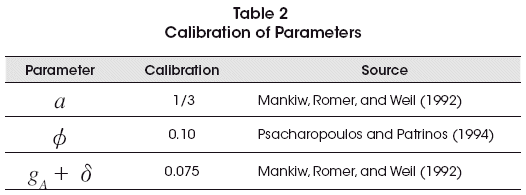
Equation 5 also requires variation across countries for SK, n, S, and Ã. Last decade averages for the physical investment rate, SK, and population growth rate, n, are computed from the Penn World Tables version 7.1. Data on average years of schooling, S, for the year 2010, are taken from Barro and Lee (2010). Finally, to estimate the relative level of technology Au in 2010, the article follows the decomposition suggested by Jones (1997a).
3.3. The Steady-State Distribution and Alternative Scenarios
3.3.1. Base Model
Given the previous setting, two results are worth noting. First, consistent with the work of Jones (1997a), the steady-state distribution of labor productivity appears very similar to the 2010 distribution (Figure 5), particularly for the poorer 70% of the sample. The standard deviation raises from 34 to 35% and the median decreases from 19 to 17%. An implication of these results is that if current policies regarding human capital accumulation and technological progress remain invariant (in relative terms across countries), divergence in labor productivity and income is expected to continue in the future.
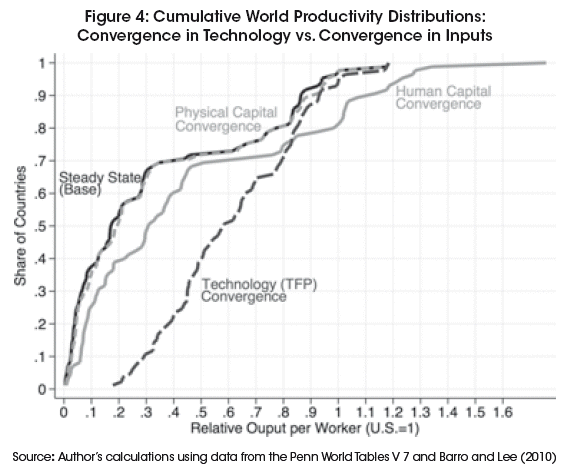
Second, although the 2010 and steady-state distribution seems broadly similar, they also exhibit some interesting differences. For example, countries which are expected to have the largest improvement in labor productivity in the near future include China, India, South Korea, Romania, and Taiwan. In contrast, countries which are expected to have the largest deterioration include the Democratic Republic of Congo, Togo, Burundi, Cote d'Ivoire, and Central African Republic.
3.3.2. Inputs Convergence: The Power of Human Capital is at the Top
In this hypothetical scenario, I first equalize the physical investment rate SK (physical capital convergence), and then the years of schooling S (human capital convergences) of all countries to that in the United States. Results of this experiment are somewhat mixed. Compared to convergence in physical capital, human capital convergence has a larger effect on the world productivity distribution. This effect, however, is concentrated at the top of the distribution. As a result, there is an increase in the disparity of labor productivity in the world. The standard deviation of relative output per worker raises from 34% in 2010 to 40%.
Evaluating the shape of the cumulative distribution, Figure 4 suggests a potential explanation for understanding the unsatisfactory results of physical and human capital convergence. Productivity at the bottom of the distribution appears sticky in spite of additional accumulation of physical and human capital (i.e., inputs). Other countries, at the middle and top of the distribution, get better returns with similar endowment levels. Thus, it is not only the low level of inputs what keeps productivity stagnant in the poorest countries, but also the way in which these inputs are used. In the next scenario, I empirically test this well known argument of the economic growth literature.
3.3.3. Technology Convergence: The Main Determinant of Convergence
In this scenario, I allow countries with less than the United States' level of technology to converge to this benchmark, and the twelve countries with higher technology maintain their advantage.
Results in this setting are more encouraging, technology convergence both shifts (Figure 4) and condenses (Figure 5) the steady-state distribution of labor productivity. Contrary to convergence in physical or human capital, the standard deviation of relative labor productivity falls from34% in 2010 to 25% in steady state. The reason for this reduction is that technological convergence shifts the entire cumulative distribution with larger effects on countries at the bottom 70% of the distribution.
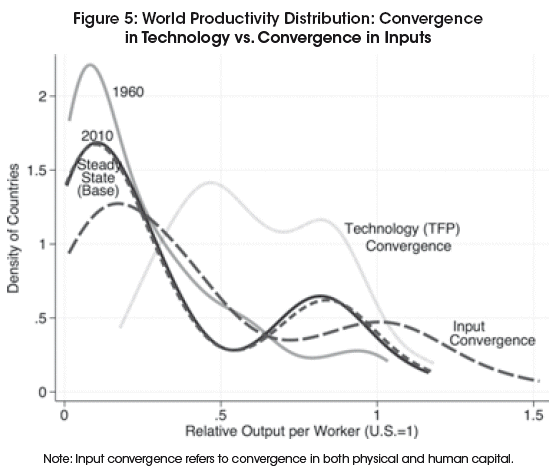
Figure 5 summarizes the different shapes of the world productivity distribution for 1960, 2010, and the hypothetical scenarios. Note that overtime the bimodal distribution persists even under convergence in inputs or convergence in technology. The twin-peaks hypothesis appears in the growth literature as a potential explanation for this phenomenon. In the next section, I use the basic tools of this literature to evaluate the probability of persistence of these two peaks.
4. Labor Productivity in the Very Long Run
Markov methods are typically used to study the evolution of a system based on initial states and transition probabilities. Mathematically, this process is described by
![]()
where the vector dt corresponds to the productivity distribution in the year t, the transition matrix M contains mobility frequencies from sample data, and s represents the number of years into the future.
The first set of columns in Table 3 reports the world productivity distribution, for the years 1960, 1985, and 2010, based on the same seven productivity intervals (states) defined in Table 1. Using Equation 6 for s = 25, s = 50, and s → ∞, one can compute estimates of the very long-run productivity distribution.
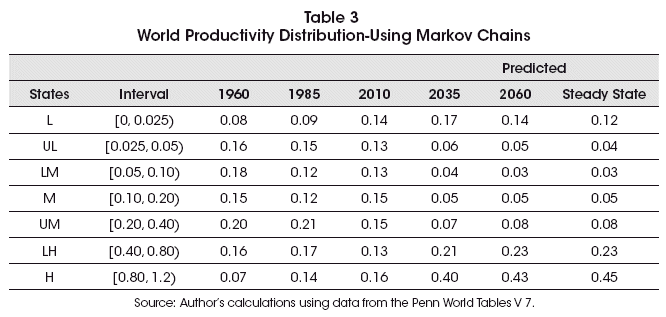
Section 3 ended with an open question: Are the twin peaks of the world productivity distribution persistent? Results from Table 3 suggest that the answer of this question has two folds. First, even in a more distant future, labor productivity may still be characterized by a bimodal distribution. Second, although the world productivity distribution appears bimodal, the two peaks are far from being twins; convergence dominates the process in the more distant long run. Consider the following example. In 1960 only 7% of countries reported a productive level higher than 80%; in the long-run, however, almost 45% of countries are expected to report a productivity level higher than 80%.
When contrasting these results with the early findings of Jones (1997b), the main differences arise at the bottom of the distribution. Jones' analysis defines the lowest interval between 0 and 5% and finds continuous convergence in income since 1988. This article, however, defines a narrower interval, between 0 and 2.5%, and it initially finds continuous divergence from 1960 to 2035 (continuous convergence emerges thereafter). Table 3 also shows that in the long-run there is a positive probability of any country spending some time in any interval. To illustrate this point, Japan, South Korea, and Taiwan are noticeable examples of countries moving to the very top of the distribution. In contrast, Argentina7 and Venezuela are drastic examples of countries moving backwards.
5. Concluding Remarks
The world productivity distribution in the post-World War II period is characterized by four remarkable facts. First, there is a large and increasing disparity between the tails of the distribution. Second, this disparity rapidly increased in the mid-1980s, slowed down in the next decade, and stabilized in the 2000s. Third, there has been substantial forward and backward mobility of countries. Forth, the upper tail of the distribution is more sensitive to improvements in human capital, while the lower tail is more sensitive to improvements in technology.8 Overall, the dynamic nature of these facts not only presents a challenge to the existing theories of development, but also provides opportunities for the development of new theories and policy initiatives.
Although disparities in labor productivity across countries are large, disparities in technology are even larger. In particular, efficiency improvements in developing countries may drastically affect the shape of the distribution of labor productivity. However, if current institutions and policies remain in place, the world productivity distribution may still be characterized by additional divergence at the bottom, and further convergence and overtaking at the top.
Fecha de recepción: 10 de agosto de 2015
Fecha de aceptación: 12 de octubre de 2015
Notas
* Kyushu University, Faculty of Arts and Sciences-Nishi-ku, Fukuoka, 891-0395 Japan Contact: mendez.carlos@artsci.kyushu-u.ac.jp
1 The data set is constructed from the Penn World Tables V7.1. The main variable is GDP per worker in chained 2005 prices, which is also PPP adjusted. Following the criteria of Duarte and Restuccia (2006), the selection of countries was based on: (1) countries have complete series for the period 1960-2010, and (2) the population size exceeds one million in 2010. For every output observation, business-cycle fluctuations are removed using the Hodrick-Prescott filter with a smoothing parameter equal to 100.
2 As noted by Sala-i-Martin (2006), increasing differences in average income per capita or average output per worker at the country level may not imply higher income inequality, or any other welfare measure, at the world level, since global inequality is also a function of within country inequality. In addition, worldwide improvements ¡n life expectancy and other health measures are not directly captured in standard productivity and income statistics, yet they help reducing income, welfare, and productivity differences in the world (Becker, Philipson, and Soares, 2005; Weil, 2007).
3 In the recent growth literature, this question was originally posted by Jones (1997a).
4 Due to the lack of systematic educational data, this section is based on a smaller 85-country sample.
5 In the growth literature, the technology parameter A is known as Total Factor Productivity (TFP) or Solow Residual. To avoid any source of confusion with use of the term “productivity”, I use the term technology (TFP) in the rest of the paper.
6 See Acemoglu (2009) for a discussion of the relationship between proximate and fundamental causes of economic performance.
7 Note that Argentina was one of the richest and most productive countries in the world in the early part of the twentieth century.
8 This finding does not imply that developing countries should left aside policies that promote the accumulation of skills. On the contrary, based on how the technology variable is constructed (i.e., as a residual) it includes some other dimensions of human capital. For instance, differences in the quality of schooling, work experience, and early childhood development may be significant human capital factors that, by lack of systematic measures, are included in the residual measure of technology.
References
1. Abramovitz, M. (1986). "Catching Up, Forging Ahead, and Falling Behind." The journal of Economic History, 46 (02): 385-406. [ Links ]
2. Acemoglu, D. (2009). Introduction to Modern Economic Growth. New York: Princeton University Press. [ Links ]
3. Barro, R., and J. Lee (2010). A New Data Set of Educational Attainment in the World, 1950-2010". NBER Working Papers 15902.
4. Becker, G., T. Philipson, and R. Soares (2005). "The Quantity and Quality of Life and the Evolution of World Inequality. American Economic Review, 95 (1): 277-91.
5. Chari, V., P. Kehoe, and E. McGrattan. (1997). "The Poverty of Nations: A Quantitative Exploration". Staff Report 204. Federal Reserve Bank of Minneapolis. http://ideas.repec.org/p/fip/fedmsr/204.html.
6. Duarte, M. and D. Restuccia (2006). "The Productivity of Nations." Economic Quarterly (Summer Issue): 195-223.
7. Jones, C. (1997a). "On the Evolution of the World Income Distribution." Journal of Economic Perspectives, 11 (3): 19-36. [ Links ]
8. ------- (1997b). "Convergence Revisited." Journal of Economic Growth, 2 (2): 131-153. [ Links ]
9. Mankiw, G., D. Romer, and D. Weil (1992). A Contribution to the Empirics of Economic Growth." The Quarterly Journal of Economics, 107 (2): 407-437.
10. Parente, S. and E. Prescott (1993). "Changes in the Wealth ofNations." Quarterly Review (Spring Issue): 3-16.
11. Psacharopoulos, G., and H. Patrinos (2004). "Returns to Investment in Education: A Further Update." Education Economics, 12 (2): 111-134.
12. Quah, D. (1993 a). "Empirical Cross-Section Dynamics in Economic Growth." European Economic Review, 37 (2-3): 426-434. [ Links ]
13. ------- (1993b). "Galtons Fallacy and Tests of the Convergence Hypothesis." Scandinavian Journal of Economics, 95 (4): 427-443. [ Links ]
14. ------- (1996). "Twin Peaks: Growth and Convergence in Models of Distribution Dynamics." Economic Journal, 106 (437): 1045-1055. [ Links ]
15. Sala-i-Martin, X. (2006). "The World Distribution of Income: Falling Poverty and ... Convergence, Period." The Quarterly Journal of Economics, 121 (2): 351-397. [ Links ]
16. Weil, D. (2007). "Accounting for the Effect of Health on Economic Growth." The Quarterly Journal of Economics, 122 (3): 1265-1306. [ Links ]














